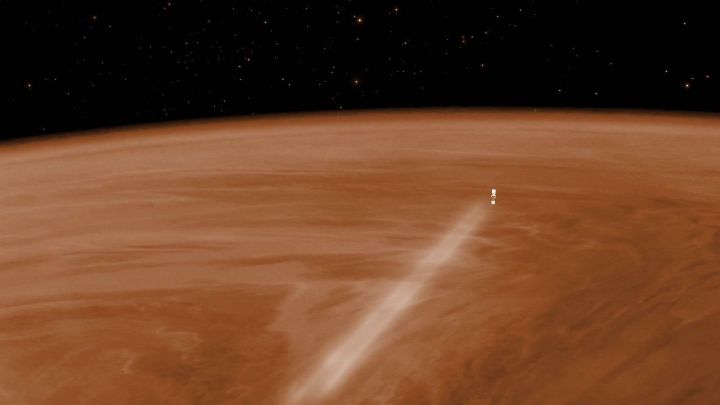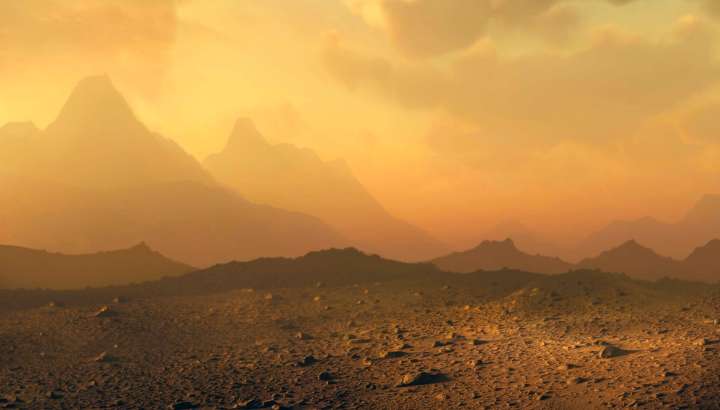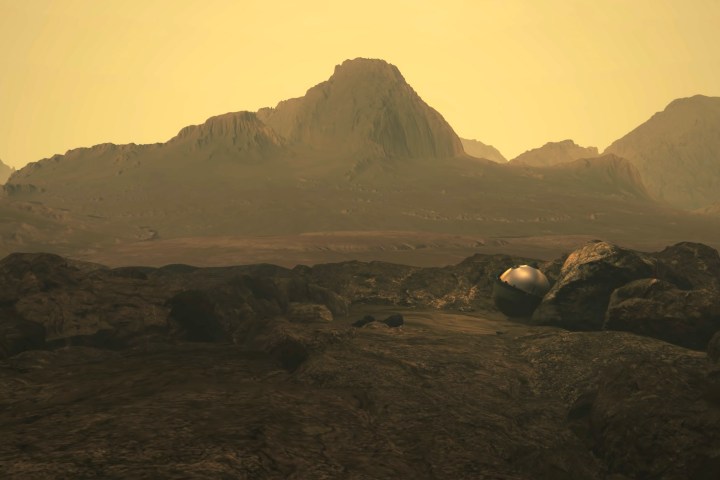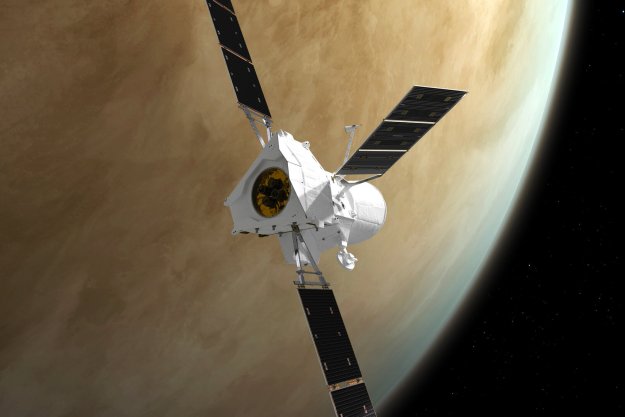
The decade of Venus is almost upon us. With three upcoming Venus missions planned from NASA and the European Space Agency (ESA), we’re on the cusp of learning more about our neighboring planet than ever before.
But we won’t only be learning about planetary science. This time we’ll also be learning how to control a spacecraft in an alien atmosphere, thanks to two missions — ESA’s EnVision and NASA’s VERITAS — which are set to use a new technique called aerobraking to get their spacecraft into the right orbit for them to do their science.
We spoke to engineers and scientists from the EnVision mission to learn how they’re planning to pull it off — and what they might learn from it.
Slowing down using the atmosphere
Normally, you’d slow down a spacecraft the same way you speed it up: by burning fuel. Chemical propulsion is a great way to produce a lot of force very quickly, and it’s what you need for both launching from your origin and entering orbit at your destination.
However, fuel is also very heavy. And weight is money when it comes to rocket launches. The more fuel a spacecraft is carrying, the more expensive it will be to launch and the less allowance there will be for scientific instruments.
So in the last few decades, space engineers have been developing a more efficient way to slow a spacecraft down. Instead of burning fuel, this new method takes advantage of the atmosphere that exists at most locations we’d want to visit. The spacecraft approaches the upper edges of the atmosphere and dips in, where friction will slow it down by a small amount. Then the spacecraft pulls back up before dipping in again, gradually slowing down over multiple dips and lowering its orbit over time.

This method, called aerobraking, has been used by spacecraft at Mars, and has even been experimented with for spacecraft returning to Earth. But now mission teams want to use the technique for two of the upcoming Venus missions as well.
A couple of previous Venus spacecraft like Magellan and Venus Express have used aerobraking at the end of their missions, when their main science work was done and the teams wanted to experiment with the technique. But EnVision and VERITAS will be the first spacecraft to use aerobraking at the start of their missions to get into the right orbit.
A 15-month marathon
When EnVision arrives at Venus, it will be orbiting at an altitude of 150,000 miles. And it needs to get all the way down to 300 miles above the surface to get the readings that the team wants. To do this, it will dip into the atmosphere thousands of times over a period of between 15 months and two years, gradually moving into the correct orbit.
This requires meticulous planning, but it also requires detailed knowledge of atmospheric conditions to predict how the maneuvers will affect the spacecraft. The biggest factors affecting aerobraking will be the temperature, density, and wind speeds, all of which vary considerably in different parts of the Venusian atmosphere.
That makes aerobraking at Venus much more complicated than aerobraking at Mars, for example. Venus has much higher gravity than Mars, which means the spacecraft will be experiencing much higher speeds when passing through the atmosphere. That’s why the process is going to take so long.
The harsh environment of Venus
Another challenge is that Venus is a profoundly inhospitable place, and that extends to its atmosphere as well. Venus is closer to the sun than Earth, so it receives considerable heat and solar radiation that the spacecraft needs to be able to withstand. And as the spacecraft drops into the atmosphere for aerobraking, the friction causes it to slow down — but that also causes heating.
The exact temperatures that the spacecraft will experience will depend on final design decisions, but it will be in the region of “maybe 200 or 300 degrees centigrade for the highest temperature,” Adrian Tighe, materials scientist for EnVision, said. There’s also the ultraviolet radiation from the sun that the spacecraft will have to handle. “It’s quite a harsh environment for the materials.”

The biggest threat to the spacecraft during aerobraking, however, isn’t the heat or the radiation. Rather, it’s a component of the upper atmosphere, atomic oxygen. Unlike most oxygen molecules on Earth, which are made of two oxygen atoms, atomic oxygen has been split by radiation from the sun and so has just one oxygen atom. That means it is highly reactive, so it can eat away at materials and corrode them.
That’s bad news for the spacecraft, which needs to survive the months-long aerobraking phase and then be able to go on to its science mission. And the spacecraft will literally be bombarded by these particles, as it will be moving at a high speed of around five miles per second. “It’s a combination of a chemical reaction and the impact speed” that will cause the issue, Tighe explained, with particles striking the spacecraft “like a speeding bullet.”
Finding Venus-proof materials
The atomic oxygen can oxidize metals, but it’s even worse for polymers. These plastic-like materials, made of carbon, hydrogen, and oxygen, react with the atomic oxygen to form compounds like carbon dioxide that evaporate away, and so that material is lost into space. Atomic oxygen can also react with paints, such as white paints that are needed to reflect heat away and that can turn brown and become less effective, as well as with insulation material called multilayer insulation.
The biggest concern is the spacecraft’s solar panels, because they are so exposed. The solar cells are covered in glass, which is resistant to atomic oxygen, but these are set into a substrate typically made of carbon fiber, which is susceptible to erosion. Another sensitive component is the thin foil used as insulation between the cell and the panel, called kapton. And there’s a thin foil connecting the different cells, which is sometimes made of silver — and that is sensitive too. So the engineers are working on either choosing different materials, or finding ways to protect the materials from exposure to the atomic oxygen.
Though atomic oxygen isn’t found much on Earth’s surface, we do have some understanding of how to deal with it as it is found in Earth orbit. Satellites are designed to withstand a certain density of atomic oxygen, so engineers are using similar principles to design the EnVision spacecraft to make it resistant. But the Earth environment doesn’t involve such high temperatures, so the combination of atomic oxygen and high temperatures is a new challenge.
“So we had to use the most robust materials,” said Tighe, whose group has been busy testing out materials like insulation, paint, and solar panel components to find the ones that will be able to withstand 15 months of this harsh environment before even beginning its main mission.
Science data for free
EnVision’s main mission won’t begin until the aerobraking maneuvers have brought the spacecraft down to its final orbit of between 130 and 340 miles. But scientists never let an opportunity to learn pass them by, so a research team is working on what they might be able to learn about Venus during the aerobraking phase as well.
Atmospheric scientists are excited about the possibility of getting an up-close view of the planet’s upper atmosphere, which is rarely studied. Studying the upper atmosphere is hard, according to EnVision scientist Gabriella Gilli of the Instituto de Astrofísica de Andalucía in Spain, because it is so thin compared to the dense lower atmosphere. “It’s difficult to measure with remote sensing instruments. We don’t have enough accuracy for instruments to measure such a small density,” Gilli explained.
That’s why the aerobraking maneuver offers such a unique scientific opportunity. By taking measurements of factors like density and temperature during the maneuvers, scientists can build up a more comprehensive picture of the upper region of the atmosphere.

“We really want to know what the state of the atmosphere is in every part of the planet,” Gilli said. But currently, the limited data we have from Venus is confined to highly localized observations. There are also vast differences between how the atmosphere behaves during the day versus during the night, which we are only just beginning to understand.
If scientists can get data on the upper atmosphere during this phase, they can compare it to data from other missions like DaVinci to try to piece together what is happening in the atmosphere as a whole, rather than in just one location.
Adjusting to conditions
The observations collected during the aerobraking phase won’t only be of scientific interest though. They will also be fed back to the spacecraft team, who can adjust the way the maneuvers are being planned if, say, it turns out that the density in one part of the atmosphere is different from what was expected.
“The Venus atmosphere is extremely variable,” Gilli explained, meaning that its temperature and density change in complex ways. “And the variability is even higher in the upper part of the atmosphere.”
That means that the limited predictions we do have about what to expect might need considerable adjustment once the spacecraft arrives at Venus. Modeling the conditions that the spacecraft will encounter will be “a continuous work in progress until launch,” according to Thomas Voirin, EnVision Study manager.
And even after launch, adjusting the aerobraking maneuvers is an iterative process. The mission team has models of what they can expect to find, but “for sure, the reality will be different,” Voirin said. The entire process is designed with wide margins, to allow for various possible deviations from predictions.
A delicate phase
Launching any interplanetary mission is difficult, but aerobraking at Venus is a particular challenge. From the fast rotation of parts of the atmosphere to the effects of solar activity, with fast winds and high variability, there are a lot of factors that spacecraft like EnVision will have to contend with.
“This is a very challenging phase. A very delicate phase,” Gilli said.
But if it works, it could demonstrate a new and more affordable way to get spacecraft into their orbits — and that means that missions can be more ambitious in their science goals without being more expensive.
The process is long, and will require patience from the researchers and the public, but it has the potential to change the way we do planetary science at Venus.
“It looks quite a complicated thing. You think, well, why would you do that? Why would you spend two years waiting for what is quite a risky maneuver? It’s because it really enables the mission,” Tighe said. And there’s something inherently satisfying about it too. “It’s just neat, using the atmosphere itself to enable you to get into the orbit. It’s a neat way to do it.”
Editors' Recommendations
- Here’s the new science that’s launching to the ISS today
- NASA’s Psyche mission launches to explore a metal asteroid
- Inside the crazy plan to scoop up and bring home a bit of the Venus atmosphere
- Launch of Europe’s Jupiter Icy Moons Explorer delayed by 24 hours
- How NASA’s astronaut class of 1978 changed the face of space exploration




